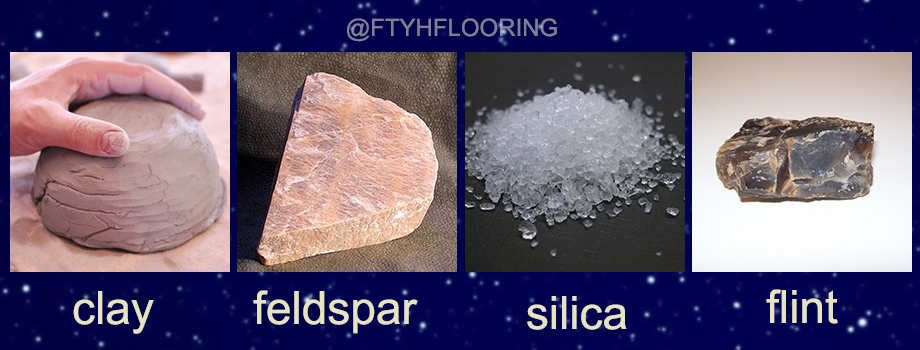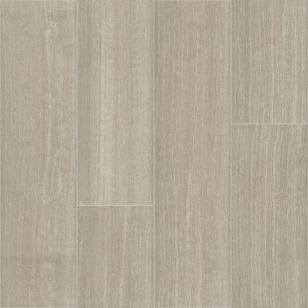How Is Porcelain Flooring Made?

What Is Ceramic Flooring?
Both porcelain and ceramic start off as natural clay, which is then mixed with a variety of raw materials like feldspar, flint, and silica. The exact proportions will vary depending on the manufacturer’s specifications. Here’s a quick breakdown of these raw materials:
• Clay is a naturally occurring rock or soil substance found all over the world. It combines one or more clay minerals with organic matter and trace amounts of metal oxide.
• Feldspar is a mineral found in the Earth’s crust. It’s commonly used as filler in paints and rubber materials and is also used in archaeological dating.
• Flint is a form of quartz.
• Silica is silicon dioxide, one of the main components of sand.

What’s The Difference Between Porcelain And Ceramic?
While it’s important to remember that porcelain is actually a type of ceramic, the differences are worth noting. The most basic differences are in clay density and firing temperature. Porcelain is made from denser clay than ceramic, and is fired at a much higher temperature. The clay used to make porcelain undergoes a more rigorous refining process to remove impurities; combined with the increased firing temperature and pressure, the finished product is dense, hard, and highly durable.
Ceramic is no slouch either. In its traditional unglazed form, certain ceramics feature a stunning rusty rose tone: the prized terra cotta, “baked earth,” in Italian. Terra cotta has been used as an ornamental building material for centuries across the world: the famed Terra Cotta Army of the Qin Dynasty were found in 1974 near Xi’an, China over 2,000 years after being built.
 A section of the Terra Cotta Army. CC BY-SA 3.0
A section of the Terra Cotta Army. CC BY-SA 3.0
What Types Are Available?
The two main types of porcelain available are glazed tile and unglazed tile. There’s no difference in the manufacturing process, but glazed porcelain tile is coated in a liquid glass finish – the glaze - then fired at very high temperatures.

A cross-section illustration of the two tile types.
Glazed Tile
Glaze gives porcelain a sleek, smooth, and stylish finish that’s available in a large range of colors. The glaze layer is nonporous, which helps prevent staining. Hardness also needs to be taken into consideration with glazed tiles: matte and satin finishes are harder than high gloss finishes and therefore less susceptible to scratches. The key to getting a tile floor that matches your beauty wants and your durability needs is balance.

Unglazed Tile
Since unglazed tiles don’t have the smooth finished surface of their glazed counterparts, they’re great for slippery areas like kitchens and laundry rooms where moisture and safety are top priorities. As a rule unglazed tiles are denser and thicker than glazed tiles, but they’re more vulnerable to staining and should be sealed and waxed as preventative measures.
Unglazed tiles can be used outside in milder climates. Always check the manufacturer’s specifications to make sure your tiles are approved for outdoor use prior to installation.
How Do I Know If Porcelain Tile Is Right For Me?
Porcelain and ceramic are great for rooms with moisture concerns. It’s been a go-to in kitchens, bathrooms, laundry rooms, and entryways for centuries, and with good reason! The variety of colors and finishes on the market help make a truly customizable flooring experience. It’s important to take safety concerns into account; wet porcelain can be very slippery and falls can cause serious injury. These risks can be alleviated with precautions like area rugs and slip-resistant materials.
In terms of installation ease, porcelain is traditionally applied with grout, a notoriously time-consuming process. Can grout be a pain to install? Yes. Does it look great when it’s installed? Also yes! It depends on your preference, timeline, and whether you’re going DIY or hiring a professional. For those in search of a more convenient option, some modern porcelains use click together installation.
If you’re looking for a combination of beauty and durability, porcelain is a great choice!
Follow Team Floors To Your Home on Facebook

 Brown Tone
Brown Tone
 Red Tone
Red Tone
 Golden Tone
Golden Tone
 Gray Tone
Gray Tone
 Light Tone
Light Tone
 Medium Tone
Medium Tone
 Dark Tone
Dark Tone
 Multi Color
Multi Color
